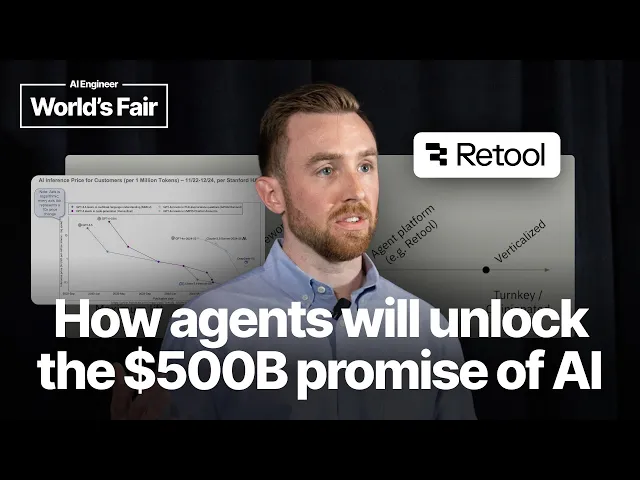How agents will unlock the $500B promise of AI

AI agents: the future of workplace productivity
In a thought-provoking talk by Donald Hruska of Retool, we're introduced to a vision of AI that extends far beyond today's chatbots and into a world of autonomous agents that promise to transform knowledge work. Hruska presents a compelling case for why AI agents represent the next frontier in workplace productivity—potentially unlocking hundreds of billions in economic value. As businesses race to implement generative AI, understanding the distinction between today's tools and tomorrow's agents could be the difference between incremental gains and revolutionary change.
Key insights from Hruska's presentation:
-
AI agents differ fundamentally from today's AI tools by their ability to take autonomous action rather than merely generating responses—they can access systems, make decisions, and complete complex workflows without constant human supervision.
-
The economic impact of AI agents could reach $500 billion annually by automating routine knowledge work tasks that currently consume 30-40% of knowledge workers' time across industries.
-
Building effective AI agents requires thoughtful integration with existing systems through APIs, custom tools, and careful consideration of control mechanisms to ensure they operate safely within appropriate boundaries.
The agent revolution: beyond chatbots to autonomous workers
The most compelling aspect of Hruska's talk is his distinction between today's AI tools and true AI agents. While companies have rushed to implement chatbots and large language models, these tools still primarily generate text based on prompts. They remain fundamentally reactive. Agents, by contrast, can initiate actions, make decisions, and navigate complex systems autonomously.
This distinction matters enormously in the business context. Consider the typical knowledge worker who spends nearly half their workday on routine tasks: gathering information from various systems, compiling reports, scheduling meetings, or processing standardized requests. These tasks require more than just text generation—they demand the ability to navigate between systems, make contextual decisions, and take concrete actions.
The transition from passive AI to active agents represents a paradigm shift similar to the move from static websites to dynamic applications during Web 2.0. When AI can not only recommend actions but actually execute them across organizational systems, we enter entirely new territory for workplace productivity.
Beyond the hype: practical applications emerging today
While Hruska paints a compelling future vision, several companies are already demonstrating the potential
Recent Videos
How To Earn MONEY With Images (No Bullsh*t)
Smart earnings from your image collection In today's digital economy, passive income streams have become increasingly accessible to creators with various skill sets. A recent YouTube video cuts through the hype to explore legitimate ways photographers, designers, and even casual smartphone users can monetize their image collections. The strategies outlined don't rely on unrealistic promises or complicated schemes—instead, they focus on established marketplaces with proven revenue potential for image creators. Key Points Stock photography platforms like Shutterstock, Adobe Stock, and Getty Images remain viable income sources when you understand their specific requirements and optimize your submissions accordingly. Specialized marketplaces focusing...
Oct 3, 2025New SHAPE SHIFTING AI Robot Is Freaking People Out
Liquid robots will change everything In the quiet labs of Carnegie Mellon University, scientists have created something that feels plucked from science fiction—a magnetic slime robot that can transform between liquid and solid states, slipping through tight spaces before reassembling on the other side. This technology, showcased in a recent YouTube video, represents a significant leap beyond traditional robotics into a realm where machines mimic not just animal movements, but their fundamental physical properties. While the internet might be buzzing with dystopian concerns about "shape-shifting terminators," the reality offers far more promising applications that could revolutionize medicine, rescue operations, and...
Oct 3, 2025How To Do Homeless AI Tiktok Trend (Tiktok Homeless AI Tutorial)
AI homeless trend raises ethical concerns In an era where social media trends evolve faster than we can comprehend them, TikTok's "homeless AI" trend has sparked both creative engagement and serious ethical questions. The trend, which involves using AI to transform ordinary photos into images depicting homelessness, has rapidly gained traction across the platform, with creators eagerly jumping on board to showcase their digital transformations. While the technical process is relatively straightforward, the implications of digitally "becoming homeless" for entertainment deserve careful consideration. The video tutorial provides a step-by-step guide on creating these AI-generated images, explaining how users can transform...
